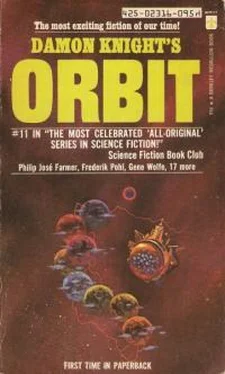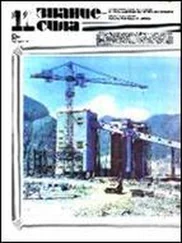Дэймон Найт - Orbit 11
Здесь есть возможность читать онлайн «Дэймон Найт - Orbit 11» весь текст электронной книги совершенно бесплатно (целиком полную версию без сокращений). В некоторых случаях можно слушать аудио, скачать через торрент в формате fb2 и присутствует краткое содержание. Год выпуска: 1973, ISBN: 1973, Издательство: Berkley Medallion, Жанр: Фантастика и фэнтези, на английском языке. Описание произведения, (предисловие) а так же отзывы посетителей доступны на портале библиотеки ЛибКат.
- Название:Orbit 11
- Автор:
- Издательство:Berkley Medallion
- Жанр:
- Год:1973
- ISBN:0425023168
- Рейтинг книги:5 / 5. Голосов: 1
-
Избранное:Добавить в избранное
- Отзывы:
-
Ваша оценка:
- 100
- 1
- 2
- 3
- 4
- 5
Orbit 11: краткое содержание, описание и аннотация
Предлагаем к чтению аннотацию, описание, краткое содержание или предисловие (зависит от того, что написал сам автор книги «Orbit 11»). Если вы не нашли необходимую информацию о книге — напишите в комментариях, мы постараемся отыскать её.
Orbit 11 — читать онлайн бесплатно полную книгу (весь текст) целиком
Ниже представлен текст книги, разбитый по страницам. Система сохранения места последней прочитанной страницы, позволяет с удобством читать онлайн бесплатно книгу «Orbit 11», без необходимости каждый раз заново искать на чём Вы остановились. Поставьте закладку, и сможете в любой момент перейти на страницу, на которой закончили чтение.
Интервал:
Закладка:
They strip me as they strip an automobile: clothes, wristwatch, shoes, teeth, eyes, ears, scalp, fingers, limbs, spleen, heart . . .
Gutted, they cram me through a drain grating into the sewers. I slide easy, into the slimy, greasy, fetid water of the river; roll into the riverbed in a flowering puff of powdered excrement that settles back down in an even blanket, softening, blurring, obliterating.
The sun was bright and clear when I awoke the next morning. I left her still sleeping, went and poured fresh pasteurized orange juice, cereal with vitamins enough for another twenty-four hours of my existence.
I felt good.
I looked outside. Sunlight had miraculously erased the darkness again. Night’s black ocean tide had withdrawn, leaving only an occasional piece of driftwood on the sidewalk shore: a bloodstained shoe, length of bent water pipe, a crushed hypodermic.
The radio news said the Empire State was bombed out again; the black surface of 7th Avenue had turned to jelly, clogging the subway beneath; and we were warned of intermittent showers of blood in the late afternoon.
John Barfoot
THE CRYSTALLIZATION OF THE MYTH
The first thing we see is a view of the desert from an immense height. It is simply a flat, reddish surface, huge cloud-shadows racing across it, filling the whole of our vision. Through its center cuts the sparkling silver ribbon of the highway. We move downward with increasing speed in a great curve which brings us out above the surface of the highway, moving quickly along its length. The signposts flicker past, the desert slides by like a backdrop, the yellow lines of the thirty lanes arrow straight to the horizon. The highway is empty, we are traveling down its center.
Ahead, we can see that the point on the horizon where the road narrows and disappears is slowly suffusing with a brown color; the brittle-feeling, softly rough color of dead leaves. The brown stain leaves the horizon and travels down the road toward us, and we can see that it covers the whole width of the highway. Behind it a long brown tail unfolds, covering half the lanes, occasionally straying across into the other half.
We slow down as it approaches us, until we stop gently before it. Our view straight ahead is of splintered glass around the edge of a frame, buckled metal, yellowed and decayed rubber. The brown color is rust.
We rise and slowly move over the great expanse of rusted metal, hesitantly, as visitors in a great cathedral move. And as cathedrals seem to breathe a cool silence of stone, so does this object seem to exude a dry, rasping silence of heat. There does, indeed, seem to be an unnatural stillness and a held feeling, a tightness of the stomach, caught in the air above and around it.
We move slowly and from this close, subjective standpoint it seems to assume a vastness in the mind, although if seen from two miles up it would hardly be visible. The air above the brown surface is warped with heat and wreathed with sun-smoke, and the force of our passage dislodges tiny particles of rust, which hang and spin in suspension for moments at a time.
We reach the edge of the main bulk and look straight along the rusty tail of metal to the horizon. Immediately in front of us, a bundle of white sticks protrudes from an oblong aperture in the metal, seeming not part of this, but a separate thing, a thing out of place in the great expanse of rusted metal. Now that we have seen this one we see others. There are quite a few of these bundles of sticks glimmering in the brown.
We cross the highway, moving over the striped safety barriers, stopping in midair. Below us, the sand is covered with small, isolated blots of brown, fallen from the main mass. A huge steel pillar thuds unmovingly into the ground at the edge of the pattern of blots, supporting the flat, raised surface of the road. We fall slowly to the ground. Above us, some sixty feet above, the highway arches, stiffspanning the earth, the metal fountaining outward and outward, a still steel river, a tense spring, caught in the insect legs of metal supports. On the other side of its width, through the cool shadow beneath it, other brown objects can be seen. One is surrounded by bundles of splintered white sticks.
We imagine the creation of the thing. We see in our minds the panic, the fear, the desperate, terrifying flight, the awful sound of the roaring engines, the screaming horns, the jangling, discordant rupture into fractured reality, lights, sounds, flashes, the flight from . . . what? All the lines meeting in this brown mass, time lines starting at different points in time, stopping, starting, moving on, from different origins, crossing and diverging, lives in all their complexity, moving forward with the irresistible pressure of predestination behind them, moving on into the blindness of time and the incomprehensible image of space. And then this strange meeting. This decaying knot of lifelines, this brown blob which is the manifestation of the intersection, the binding together of the spidering separate lines, the web of the incomprehensible, enigmatic accident.
The thing seems to us to be a work of art, an attempt at communication, as if the poet despaired of making himself understood by direct attacks on his meaning and attempted the touching of intellects indirectly. The enigma of the poem.
And perhaps, perhaps it is a work of art, by an artist incomprehensible to us. One who weaves the strands of fate and time, one who moves the lives of men; world-strider, he, stars his jeweled footsteps. Perhaps there is a standpoint, a way of looking at the object, a state of mind, perhaps, from which the pieces will fall into place, turn and spin with the eye, and reveal. . . .
Perhaps something which will have duration in a world of sputtering stars, dying planets, fading gaseous life.
We move, trying to find the standpoint.
Cut / broken glass / Cut / twisted steel / Cut / melted rubber / Cut / tarnished silver mascot.
There is no such standpoint. All we see is the vast sun-welded structure of wrecked cars and bones.
We rise and turn toward the brown tail, following it to its origin, skimming over the almost unrecognizable hulks of the automobiles. A brown stain appears on the horizon. It grows and grows, vast, vaster. Buildings, towers, spreading sideways in the distance. We move toward the myth leaving behind us its crystallization.
Hank Davis
TO PLANT A SEED
In a dark place which is filled with light, but none for seeing, are nine figures. They do not move.
People have been known to voice opinions:
1) “The seed? Well, I don’t know, now. Never had a garden myself. What kind of seed do you mean?”
2-6) Omitted because of similarity to 1).
7) ”Sure, I’ve heard of the Seed. Can’t see any reason for it. Why should they spend so much money for something that nobody will live to see? That’s what I say. We’ve got enough problems to solve right now without throwing money away on something billions of years in the future.”
8) ”If those people want to commit suicide together, it’s all right with me, but why use my tax money to do it? Even the people working on the Seed admit that there’s no way it can benefit anybody now living or anybody who will ever live in this universe.”
9) ”Never mind basic research, because there is no information to be gained. And I really am not concerned about the money required, not because I don’t think that it could be put to a better use, but because I don’t think it would be put to a better use, Seed or no Seed. My objection is that this project is the last gasp of the notion that man is master of the universe and the cosmos belongs to him. That notion nearly made the Earth uninhabitable in the last century and we’re better off without it. If we want to build a Seed and give the next universe the dubious gift of human inhabitants, why such a hurry? We have billions of years ahead of us. For once in our thoroughly botched career, let’s take time to think it over.”
Читать дальшеИнтервал:
Закладка:
Похожие книги на «Orbit 11»
Представляем Вашему вниманию похожие книги на «Orbit 11» списком для выбора. Мы отобрали схожую по названию и смыслу литературу в надежде предоставить читателям больше вариантов отыскать новые, интересные, ещё непрочитанные произведения.
Обсуждение, отзывы о книге «Orbit 11» и просто собственные мнения читателей. Оставьте ваши комментарии, напишите, что Вы думаете о произведении, его смысле или главных героях. Укажите что конкретно понравилось, а что нет, и почему Вы так считаете.


